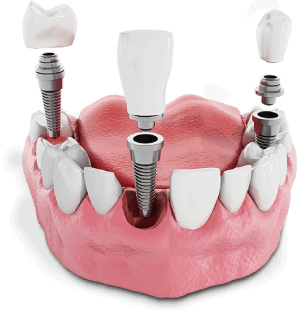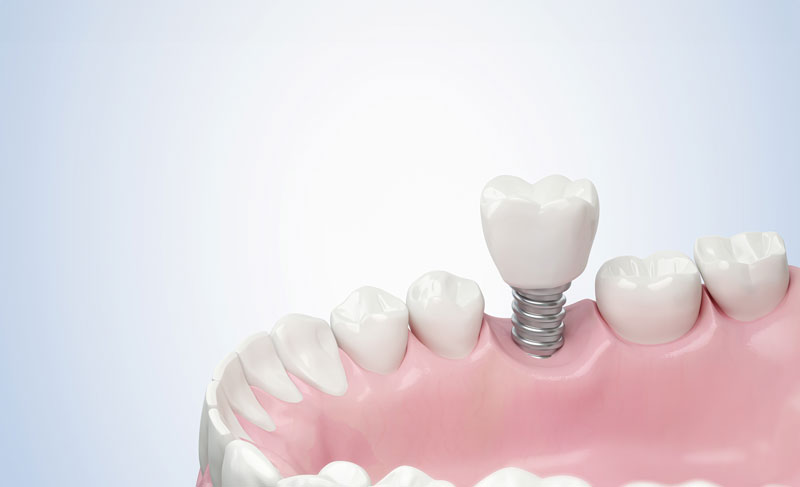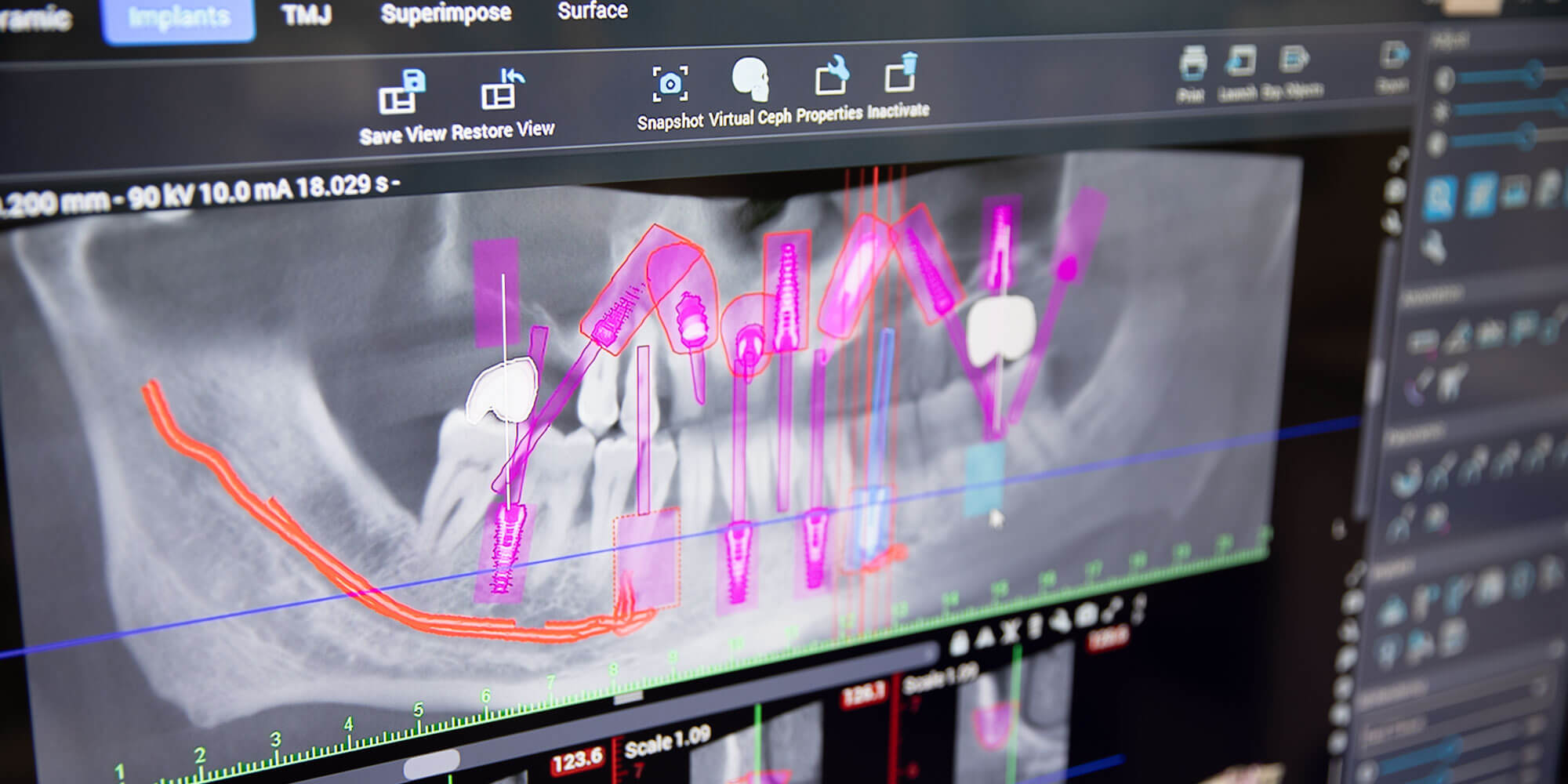Missing Teeth Can Affect More Than Your Smile
Missing teeth can affect more than appearance. They may impact speech, chewing, and overall oral health. When a tooth is missing, the surrounding teeth may shift, which could lead to misalignment. Without stimulation from a tooth, the jawbone may lose density over time. These changes can influence facial structure and daily function.
Dental implants offer a long-term solution to tooth loss. They differ from temporary tooth replacement options like dentures or bridges as they are designed to act like natural teeth and support jawbone health.
Since dental implant treatments are highly personalised, the step-by-step procedures can vary. To learn how your procedure may be tailored, you can book a free consultation with our experienced dental professionals at FoX Implant Centre. We will assess your needs and goals to figure out which treatment approach will produce optimal results.
What is a Dental Implant?
Dental implants are artificial tooth roots made from biocompatible materials like titanium. They are placed into the jawbone through a surgical procedure, where they fuse with the bone in a process called osseointegration. This forms a strong foundation for replacement teeth, such as dental crowns, bridges, or implant-supported dentures.
Unlike temporary treatment options like dentures or bridges, dental implants are designed to provide long-term solution. Dentures can shift, cause discomfort, and require regular adjustments. Dental bridges rely on neighbouring teeth for support, which may weaken them over time. Implants, however, function like natural teeth, offering better stability, comfort, and bone preservation. They also improve chewing, speech, and overall oral health.
Dental implants are ideal for people with missing teeth who have good oral health and sufficient jawbone density. Those with bone loss may still qualify after a bone graft. Implants also support single teeth, multiple teeth, or a full arch, making them a versatile option for tooth replacement.
A Step-by-Step Guide to the Dental Implant Procedure
The dental implant procedure involves several stages. Below is a step-by-step guide to help you understand the dental implant process from start to finish.
Initial Consultation
The procedure begins with an initial consultation. During this appointment, our dental professionals will assess your oral health, discuss your goals, and determine if you are a suitable candidate for dental implants. Your medical history will be reviewed, and a detailed examination of your mouth will be conducted.
This step allows the dentist to identify any issues that might affect the procedure, such as gum disease or bone loss. Based on this evaluation, the dentist will provide an overview of your treatment options and answer any questions you may have.
Treatment Planning
Once you are deemed a suitable candidate, a personalised treatment plan is created. This treatment plan outlines every step of the process, including the type of implant required, the number of tooth implants needed, and any additional procedures that may be necessary.
At FoX Implant Centre, we use advanced Digital Smile Design (DSD) technology instead of traditional X-rays. This advanced 3D imaging system captures detailed images of your teeth, gums, and facial features. It allows for precise treatment planning, ensuring that the implants are placed with accuracy to achieve the best functional and aesthetic results.
Preparatory Procedures
In some cases, preparatory procedures are needed to create a suitable environment for the implant. These procedures may include bone grafting, sinus lifts, or tooth extractions.
Bone grafting is recommended when there is insufficient bone density to support an implant. A sinus lift may be required when the upper jaw does not have enough bone height, particularly in the area of the upper molars. If a decayed or damaged tooth is present, a tooth extraction will be performed to make space for the implant.
Pre-Surgery Instructions
Before the day of surgery, you will be given instructions to prepare. This may include dietary guidelines, such as avoiding food and drink for a specified period before the procedure.
Your dentist will also provide information on what to expect on the day of the surgery, how to dress comfortably, and any medications you may need to take or avoid.
Sedation
Sedation is an important part of the implant procedure. It ensures patient comfort and reduces anxiety.
At FoX Implant Centre, we offer local sedation and even in-house general anaesthesia for those who require a deeper level of relaxation. The type of sedation used will be discussed and agreed upon during your consultation, ensuring that you feel comfortable and at ease throughout the procedure.
Dental Implant Placement Surgery
This is when the dental implant is surgically placed into the jawbone. The dentist makes a small incision in the gum to expose the bone. A hole is drilled into the jawbone, and the implant post is inserted into this space. Once in place, the gum tissue is closed around the implant to protect it as it heals. A temporary dental crown is attached while waiting for your gums to heal around the implant, so you never have to go without teeth.
Healing and Osseointegration
Following surgery, the healing process begins. Osseointegration is the process where the jawbone grows around the implant, anchoring it securely in place. This stage is crucial as it ensures the long-term stability of the implant.
Healing times vary, but it typically takes several months for the bone to fully integrate with the implant. During this time, you may be advised to follow specific aftercare instructions to aid recovery.
Abutment Placement
Once osseointegration is complete, an abutment is attached to the implant. The abutment serves as a connector between the implant post and the replacement tooth. To place the abutment, the gum is reopened to expose the implant, and the abutment is secured. The gum tissue is then left to heal around the abutment, which typically takes a few weeks.
Crown or Prosthetic Attachment
The final stage of the procedure is the attachment of the replacement tooth or prosthetic. A custom-made crown, bridge, or denture is secured to the abutment, completing the restoration. At FoX Implant Centre, these prosthetics are crafted in our advanced in-house laboratory using premium-grade acrylics and the latest in dentistry technology, ensuring a precise fit and natural appearance.
Does It Hurt?
One of the most common questions about dental implant surgery is whether it hurts. The good news is that the procedure itself is typically pain-free. Sedation and anaesthesia are used to keep patients comfortable during the surgery. You may feel pressure or slight movement, but pain is not usually experienced.
After the procedure, some mild discomfort, swelling, or tenderness in the gums and jaw may occur. This is part of the normal healing process. Most patients report that the discomfort is less than what they experience with a tooth extraction. However, the level of discomfort varies depending on the number of implants placed and whether other procedures, like bone grafting, were required.
Pain relief can be managed with over-the-counter pain medications and any specific aftercare instructions will be provided by your dental professional. Most people are also able to return to their daily activities within a day or two.

Recovery and Aftercare
Recovering from a dental implant procedure is a gradual process. Here’s what you can expect during the healing period:
Immediate Post-Surgery Care
Immediately after dental implant surgery, you’ll likely feel numbness in the treated area due to the local anaesthetic. As it wears off, mild pain or discomfort may occur, but this is manageable with over-the-counter pain relievers or prescribed medications.
Swelling is common after surgery and may affect the gums, cheeks, or jaw for a few days. Applying a cold compress in short intervals can help reduce it. Light bleeding may also occur for the first 24 to 48 hours, but this can be controlled by gently biting down on gauze. Tenderness around the implant site is expected, and bruising may appear on the cheeks or gums but typically fades within a week.
To manage these side effects, it’s best to rest on the day of surgery and avoid strenuous activity. Eating soft foods like yoghurt, soup, and mashed vegetables can make meals more comfortable. The implant site should also be kept clean with gentle rinsing, but vigorous mouthwashing should be avoided for at least 24 hours. Following your dentist’s instructions and attending regular check-ups will help ensure smooth healing.
Healing Timeline
In the first week, you may experience swelling, mild pain, and bruising. Any bleeding should stop within 48 hours, and soft foods are recommended. By week two, swelling and tenderness reduce, and you can resume normal daily activities. Gum healing continues, and stitches may be removed if used.
During weeks 3 to 4, the gums heal further, and tenderness fades. While eating habits may normalise, chewing directly on the implant site should still be avoided. From week 5 to 12, osseointegration occurs as the implant fuses with the jawbone. This process is crucial for implant stability.
By 3 to 6 months, osseointegration is typically complete. Your dentist may then place the abutment and final crown, restoring full function.
Diet and Lifestyle Adjustments
After dental implant surgery, your mouth needs time to heal, so certain foods and lifestyle changes are recommended to support recovery.
For the first few weeks, avoid hard, crunchy, or sticky foods like nuts, chips, raw vegetables, toffees, and chewing gum. These can irritate the implant site or dislodge healing tissue. Hot drinks and spicy foods should be avoided in the first 48 hours, as they can increase swelling or bleeding. Instead, stick to soft, cool foods like yoghurt, mashed vegetables, and smoothies (without a straw).
Lifestyle changes are also essential. Avoid smoking and alcohol, as they can slow healing and increase the risk of infection. Maintain good oral hygiene, but avoid brushing directly on the implant site until advised. Use a gentle mouth rinse and attend all follow-up appointments with your dentist.

Maintaining Your Dental Implants
Proper care and maintenance are essential to keep dental implants healthy and long-lasting. Here’s what you need to do:
Brush Twice Daily: Use a soft-bristle toothbrush and non-abrasive toothpaste to clean around the implant, abutment, and crown.
Floss Daily: Floss around the implant to remove plaque and debris. Special floss or interdental brushes may be recommended.
Use Antibacterial Mouthwash: A gentle, dentist-approved mouthwash can help reduce bacteria and protect gum health.
Maintain Regular Check-Ups: Attend follow-up appointments and check-ups as advised by your dentist. They’ll assess the implant’s stability and overall oral health.
Schedule Professional Cleanings: Visit your dental clinic for professional cleanings to remove tartar and plaque from hard-to-reach areas around the implant.
Avoid Hard or Sticky Foods: Reduce the risk of chipping the crown or damaging the implant by avoiding hard lollies, ice, and sticky sweets.
Protect Against Teeth Grinding: If you grind your teeth at night, consider using a custom night guard to protect the implant.
Quit Smoking: Smoking can affect bone health and slow healing, increasing the risk of implant failure.
Potential Risks and Complications
Dental implants are generally safe with a high success rate. However, like any surgical procedure, there are some potential risks and complications to be aware of. These risks are rare but worth understanding before undergoing treatment.
Infection: Bacteria can enter the surgical site, leading to gum or bone infections.
Implant Failure: This occurs when the implant doesn’t fuse with the jawbone (osseointegration) or becomes loose due to insufficient bone density or poor oral hygiene.
Nerve Damage: Nerves near the implant site can be affected, causing numbness, tingling, or pain in the lips, chin, or gums.
Sinus Issues: Implants placed in the upper jaw may affect the sinuses, particularly if the bone height is insufficient.
Bone Loss: If the surrounding bone weakens or deteriorates, it may affect implant stability.
At FoX Implant Centres, we aim to reduce the potential risks associated with dental implants through end-to-end in-house care. Every stage of the procedure is managed by the same experienced team, from the initial consultation to the dental surgery and the creation of your custom prosthesis. This approach eliminates the need for multiple appointments at different locations, improving continuity of care and enhancing overall outcomes.
Are Dental Implants Right For You?
Dental implants are a reliable option for people looking to replace missing teeth with a durable, natural-looking solution. However, not everyone is an ideal candidate. Factors like jawbone density, gum health, and overall oral health play a key role in determining eligibility.
Ideal candidates for dental implants include people with one or more missing teeth, those who want a long-term alternative to dentures or bridges, and individuals with healthy gums and sufficient jawbone to support the implant. Good oral hygiene and a commitment to regular check-ups are also essential for success.
If you’re unsure whether you’re a suitable candidate for dental implants, book a free consultation at FoX Implant Centre. Our expert team will assess your oral health, review your treatment options, and develop a personalised treatment plan to restore your smile with strong, natural-looking new teeth.
Get implant pricing and financing options,
Including your superfund!
Find Out If You're A Candidate!





